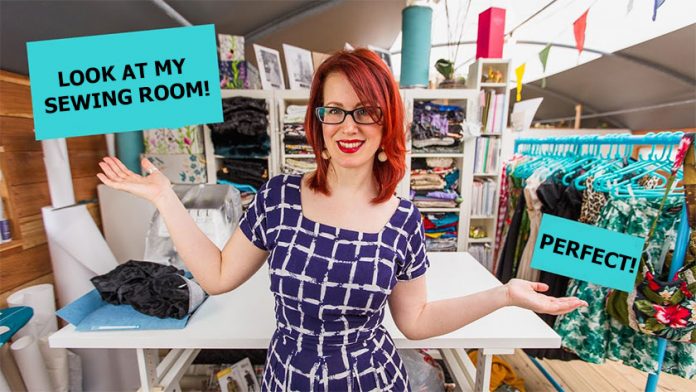Few pastimes are as rewarding as the ancient art of wielding needle and thread. Whether you use sewing as a creative outlet, a way to save money or simply to keep yourself occupied, the task can sometimes feel uninspired or thankless. Especially in the absence of a permanent workstation, when taking your machine out from on top of your wardrobe and sifting through bags to find the right fabric and thread can feel like a chore. This is a problem that hobbyists and artisans of any kind can encounter, and just like a mechanic has their dedicated garage, the best way around this is by setting up a sewing room or space of your own.
If you are not fully convinced that the ease of having specific space for sewing is enough to warrant creating one, consider the fact that setting up a sewing room also means you have a safe haven from the hustle and bustle around you. Less frequently will you be distracted by those sharing your house, so that you can let calm and inspiration sweep you away. And, if your interests extend into other crafts, you can make this space appropriate for those too. An organized and well thought out sewing space will reward you, both in its creation and result, and we will show you some ideas on how to get started. Remember, finding the best sewing machine from so many options is not enough, you also need a suitable environment to make good use of it.
Finding Your Space

The first step when embarking on this project is to find an adequate space. If you are lucky enough to have a free spacious room, it is not a bad idea to consider using this space. It is surprising how easy it is to run out of storage space or worktops when in the throes of a project, but if a large room is not realistic these are all sewing room ideas for small places too. Bigger might be better, but even the smallest of devoted sewing spaces can have a big impact on your work.
The most important things to consider about your space are ample lighting and plenty of electrical sockets, you will be surprised at how quickly space on these can run out. In terms of colors for the room, colder colors are meant to calm and warmer colors are meant to excite, so you can take this into consideration when painting the walls. But keep in mind, the more neutral the color scheme the better it will age and the more your materials and fabric will stand out, which can be an inspirational asset.
From once you have decided on a space, assess the furniture and storage that is built into it or too hard to remove based on what they might be useful for. Then, the easiest way to get started is to draw up a simple floor plan for the room, including the furniture you already have and what you want or need, making sure that the lighting and socket situation in the room fit with your plans.
Depending on the size of your space, you might have to prioritize certain areas over others. Ideally, you should have at least an area for sewing and one for auxiliary activities like pressing and cutting. The more space you have, the more areas you can dedicate to specific parts of your creative process.
Make sure that it is easy to move between areas. For example, if you have enough space, place your workstations in the middle of the room surrounded by storage. This way, you can easily rotate between work areas and access your materials at any time. If you are limited for space, maximize the amount of work surface you can create. it is a lot easier to find creative storage solutions than to have to move your equipment around regularly.
Choosing Your Furniture

After you have created a layout for your new sewing space, the next step is to decide on your furniture. You will need plenty of work surface, specialist sewing and cutting tables are great options, but if you are working on a budget comfortable desks or tables will do the trick.
You will need plenty of storage space for your fabric and notions, anything from cabinets to wardrobes will work but if at all possible make sure that there is plenty of storage for all your essentials below and around your worksurfaces. Many cutting and sewing tables come with built-in storage, but in a pinch, a filing cabinet under your desk and an organizer to the side will do the trick.
Do not overlook the need for plenty of storage and make sure that the storage areas are versatile. For example, use open storage for larger pieces of fabric so that you can easily reach them and look at them for inspiration. And use cabinets for the organized storage of samples and drawer organizers to keep your nations neat accessible.
However, the organization is not everything, sometimes a bit of chaos can be good for inspiration, so consider hanging pinboards on the wall where you can hang fabric samples and drawings without much thought may be beneficial.
Also, make sure that you have space for a computer even if you do not use a computerized sewing machine, the internet is a great place to find designs, inspiration and guides. You can consider having a dedicated sewing computer, or alternatively, make sure you have furniture for your laptop or tablet.
In terms of equipment, apart from the aforementioned, make sure you have room any specialized tools and machines you might need, but more importantly still make sure that you have enough lighting. If your new sewing room does not have enough lighting you will strain your eyes and your work will suffer. When in doubt, get extra lamps. These do not have to be expensive, desk lamps will do, but you can get specialized lighting, for example with built-in magnification, if you so wish.
If you only have you do not have as much space to devote to this project, a little bit of creativity and prioritization make these ideal sewing room ideas for small spaces too. Afterall not everyone will need a separate quilting and stitching area. Try to create at least two desk areas, one where you can keep your sewing machine and another multi-purpose area, for example for a computer or cutting mat.
The last step is to arrange the furniture according to your floor plan and you should be ready to go.
Storage and Organization

Now that you have all your furniture it is time to get organized, and the first step is to decide where to store what. As a rule of thumb, store what you will need frequently near where you will need it so that when you are in the middle of measuring your fabric for a quilting session you won’t have to walk across the room to find your ruler.
Depending on your changing habits and projects, over time you might have to reorganize layout of your materials once in a while. But with a little trial and error and some common sense, you should be able to make your room as ergonomic as necessary.
While being organized is great from a practical point of view, it is not the be-all and end-all of setting up your room. For some people, a less restrained or even messy approach might be advantageous, just because combining patterns and colors in unexpected ways can lead them to find inspiration. If this suits you more that is fine, just make sure to know in which general areas you put your materials or you might find yourself wasting a lot of time in the future.
For those who love to be ultra-organized, a good way to keep on top of where everything is in your room is to categorize and catalog designs and materials. These can then be filed away in specific areas so you will easily be able to find them.
If you feel your space is lacking in color, use some of your materials and fabric to decorate the room and make sure your storage is as outwardly visible as possible.This way, you will add flair to the room and perhaps some inspiration the next time you look round the room when quilting.
Things to Keep in Mind

Before purchasing furniture for your equipment and materials, make sure that they can hold the size and weight of anything stored on or in them. Also, make sure that the height of any work surfaces is right for you and your method of working. For example, if you prefer to stand, make sure the desk is high enough, or better still can be raised so that you do not strain your back. If you tend to sit at your desk, make sure you can reach over it well and do not strain your back leaning over it.
The next thing to keep in mind is that your preferences, and thus what you want out of your sewing room, will change over time. The more modular your approach to designing the layout and choosing the furniture when setting up your sewing room, the easier it will be to adjust in the long run. This is especially important for people who use the space for many different types of craft and projects.
Aside from making sure that you have enough power sockets, also use surge protectors when using power strips. You will be surprised at just how much power a sewing room can use and how much damage a power surge can do. So to ensure the safety of your equipment and yourself, make sure you take the adequate precautions.
You’re All Set and Ready to Go

Now the only thing left to do is for you to take those daydreams of craft heaving and turn them into reality. Not only will setting up a sewing room make sewing easier, the process itself is immensely rewarding and inspirational. No matter how much space you have or what your budget is, a dedicated space is a must for any enthusiast. And just as with sewing, to make those fantasies a reality, all you need is a little forward thinking and motivation and you will have a unique space set up for your designs and ideas in no time.
 Home
Home Sewing, Embroidery & Serger
Sewing, Embroidery & Serger Cutting machines
Cutting machines Brands
Brands Review
Review






































